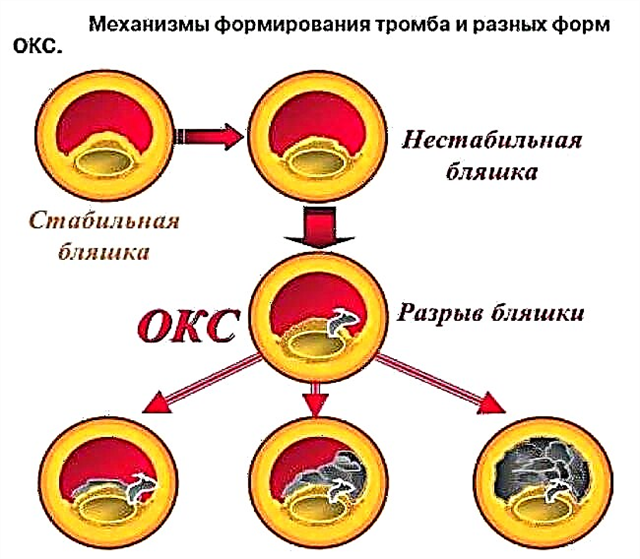When a patient is admitted to the hospital, I, as a cardiologist, always determine at what stage the disease is: I conduct an ECG in dynamics, evaluate the results of a blood test and the general condition of the patient. This allows you to decide on further actions to provide assistance. Let's see what stages of myocardial infarction are distinguished in time, how they differ from each other and what happens in each period with the heart muscle.
Myocardial infarction by stages
In most patients, myocardial infarction develops gradually. First, in a patient with angina pectoris, the frequency and duration of heart attacks increases, the threshold of physical activity decreases, pains occur in the retrosternal region, which have not bothered for many years. And "Nitroglycerin" does not relieve pain syndrome as quickly as before.
After the onset of an attack and the appearance of persistent ischemia and necrosis, 4 stages of the development of a heart attack are distinguished, each with its own clinical symptoms and manifestations on the cardiogram.
The most acute stage
Duration - from 10–20 minutes to several hours. Unstable angina pectoris develops into a heart attack:
- Sharp pain is no longer relieved by nitrates and disappears after the use of narcotic analgesics.
- The pain is pressing, constricting, burning.
- With a classic manifestation, it is determined in the chest on the left, gives under the left shoulder blade, collarbone, neck, lower jaw, half of the head.
With an objective examination:
- Pale skin, cold sweat, blue nasolabial triangle.
- Auscultation is marked by the muffling of the I tone in the apex zone.
- The heart rate is changing. According to statistics, rhythm and conduction disturbances, tachycardia or bradycardia, are observed in 90% of patients.
- The pressure first rises and then falls.
- Shortness of breath appears, in some cases there are signs of pulmonary insufficiency.
- In the analysis of blood, an increase in the level of troponin and myoglobin is noted.
The ECG shows a sharp decrease in the R wave, a significant rise in ST above the isoline and its merger with T (monophasic curve).
The morphology of the tissue changes. The lesion has distinct boundaries, the myocardium becomes pale, edematous. On the second day, the ischemic area turns yellow, and a demarcation line appears.
Read more about the ECG signs of a heart attack here.
Sharp
Lasts up to 10 days. The anginal pain, characteristic of the most acute stage, passes. Low blood pressure persists, signs of heart failure are growing. Rhythm and conduction disturbances almost always progress. In the first two days, the resorption-necrotic syndrome comes out on top:
- The temperature rises, no higher than 37.5 ° C. If the indicator is higher, then this indicates the addition of an infection. Lasts 5-7 days.
- The level of leukocytes in the blood, mainly neutrophils, increases, and ESR increases.
- In the blood, markers of cardiac muscle necrosis are determined (increased myoglobin, ALT, AST, troponin).
On the cardiogram, the acute stage of the developed myocardial infarction is clearly manifested, especially with extensive lesions. At this time, the formation of a pathological Q wave occurs, T becomes negative, ST maintains a position above the isoline.

On a histological section, an area of damage with lysis of nuclei and necrotic decay of cells is clearly visible (arrow above). At the bottom, the pointer indicates the demarcation area with tissue infiltration with leukocytes, the formation of new capillaries and edema. It is located on the border of the infarction area and the normal myocardium.

Subacute
The subacute stage of myocardial infarction lasts from 10 days to 1-2 months. For this period, the characteristic features are:
- Complete cessation of pain in the heart.
- In many patients - restoration of conduction and rhythm.
- Respiration normalization.
- Heart sounds become louder or remain muffled, depending on the extent of the damage.
- The temperature and the picture of the general blood test returns to normal.
- The pressure is normalized.
ECG: The Q wave goes directly into R, with a large-focal lesion, R disappears, the ventricular complex takes the form of QS, ST returns to the isoelectric line, T becomes negative.
If you make a cut at this time and examine the microscope, then the area of the lesion of a gray-pink shade with a red border along the periphery will be clearly defined on it.
Scarring
It develops within 2-6 months from the onset of the disease. In the stage of scarring (the formation of cardiosclerosis), recovery processes are observed, the myocardium adapts to work in new conditions:
- Many patients develop left ventricular hypertrophy (compensatory mechanism).
- Gradually returns to the initial readings of the threshold exercise tolerance.
- Very rarely episodes of rhythm disturbances are observed, in most patients the rhythm is normalized.
- The likelihood of hysteria, phobias and other neurological abnormalities increases.
The cardiogram shows a decrease in the pathological Q wave, ST remains on the isoline, the amplitude of negative T decreases or it goes to the isoline. This is a sign of scar formation.
On histological examination, it looks like a white formation, slightly sinking inward and consisting of granulations. Repeated heart attacks, angina pectoris and hypertension lead to the development of cardiosclerosis where there are many such areas and they cannot perform their previous functions. The morphogenesis of such changes is clearly visible in the attached photo.

Below you can see the dynamics of changes in laboratory parameters, depending on the time of development of necrosis.
Clinical case
A patient was admitted to the hospital with severe chest pain, which lasted for three days. Taking analgesics and "Nitroglycerin" did not bring relief. Earlier, the diagnosis of angina pectoris of FC II was made. A week before the attack, he experienced severe stress, his condition worsened. The cardiogram revealed a large-focal infarction with localization in the anterior wall, an acute stage. In the blood - an increase in myoglobin and troponin.
After a month of hospitalization, the patient was discharged for treatment on an outpatient basis. EKG showed scarring in the affected area, blood counts returned to normal.
Expert advice
When the first signs of a heart attack appear, measures should be taken immediately. I advise you to immediately call an ambulance, and while the doctor is traveling, provide the patient with complete rest, sit or put him in a position that will make the condition as easy as possible. Give Corvalol, Nitroglycerin, Aspirin, ventilate the room.
The most dangerous is the most acute period, which is usually manifested by very severe pain, shortness of breath, rhythm disturbances. The patient's life depends on the speed and correctness of the actions of the person nearby. It is best to describe the symptoms when calling a doctor so that a specialized team can come to take an ECG, give oxygen and inject drugs to limit the zone of necrosis.



